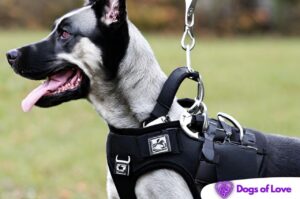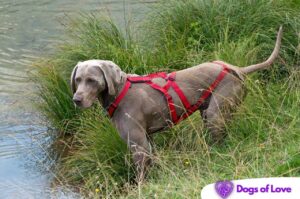When it comes to walking and controlling your canine companion, the choice between a harness and a leash is a decision every dog owner must make.
While leashes have been a traditional and popular choice, harnesses have gained increasing attention in recent years.
The debate over which is better – a harness or a leash – goes beyond personal preference and delves into safety, comfort, and effective control.
In this exploration, we’ll delve into the compelling reasons why a harness might be the superior choice for your four-legged friend, considering not only the well-being of your dog but also the peace of mind it can offer you as a responsible pet owner.

Overview of Harnesses and Leashes and the Benefits of Using a Harness
Harnesses and leashes are two distinct tools for walking and controlling your dog, each offering unique benefits.
Leashes, typically made of a simple strap or cord, attach to your dog’s collar and provide a direct connection between you and your pet.
While leashes offer a straightforward means of control, they can sometimes exert pressure on your dog’s neck and windpipe, potentially leading to discomfort or injury, especially in dogs prone to pulling.
Harnesses, however, distribute the force more evenly across your dog’s chest and back, reducing the risk of strain or injury.
They also offer improved control, making it easier to manage even strong or energetic dogs while discouraging pulling behavior.
Additionally, harnesses are more escape-proof than collars, making them a safer option for dogs that tend to slip out of their collars.
Harnesses come in various styles, including step-in, vest, and front-clip harnesses, catering to different needs.
Overall, the benefits of using a harness are centered on safety, comfort, and effective control, making it a valuable alternative for many dog owners.
What to Consider When Choosing a Harness?
Choosing the correct harness for your dog involves several crucial considerations.
First and foremost, ensure a proper fit.
Measure your dog’s girth and consult the manufacturer’s sizing guide to select the correct size, ensuring the harness isn’t too tight or loose.
The type of harness matters, too.
Front-clip harnesses deter pulling, while back-clip harnesses offer more comfort.
Consider your dog’s behavior and specific needs.
For larger or more energetic dogs, opt for a no-pull harness.
Material is another crucial factor; durable, breathable materials are ideal. Reflective elements can enhance safety during nighttime walks.
Additionally, the ease of putting on and taking off the harness should be convenient for both you and your pet.
Ultimately, the choice should be based on your dog’s size, behavior, and walking habits, ensuring a comfortable and effective solution for both of you.
What are the Types of Harnesses Available for Different Breeds?
Various harness types are available to cater to the specific needs and body shapes of different dog breeds.
For smaller breeds or those with delicate necks, a step-in harness is a comfortable and secure choice, allowing easy, hassle-free wearing.
Vest harnesses are well-suited for more extensive and substantial breeds, offering excellent control and support.
Front-clip harnesses are an excellent option for dogs prone to pulling, encouraging them to walk more gently.
Back-clip harnesses are versatile and work well for dogs of various sizes and temperaments, providing comfort and ease of use.
Specialty harnesses like no-pull or anti-escape designs address specific behavioral or training requirements.
By considering your dog’s breed and individual characteristics, you can select the most appropriate harness type to ensure safe, comfortable, and effective walks with your four-legged companion.
How to Properly Fit Your Dog for a Harness?
Properly fitting your dog for a harness ensures their comfort and safety during walks.
First, measure your dog’s girth, the widest part of their chest, just behind the front legs.
Consult the manufacturer’s sizing guide for the harness you’ve chosen, and select the size that aligns with your dog’s measurements.
The harness mustn’t be too tight, as this can cause discomfort or chafing, but it also shouldn’t be too loose, as it may lead to escape or ineffective control.
Once you’ve chosen the correct size, adjust the harness straps to fit snugly, but allow a couple of fingers to fit between the harness and your dog’s skin.
Always check for any rubbing or signs of discomfort during the first few uses and make necessary adjustments.
A properly fitted harness ensures a secure and comfortable walking experience for your canine companion.
How to Transition from a Leash to a Harness?
Transitioning from a leash to a harness is a relatively straightforward process that can be accomplished gradually to ensure your dog’s comfort.
Start by introducing your dog to the harness indoors, allowing them to sniff and explore it.
Then, put the harness on your dog without attaching a leash and reward them with treats and praise to create a positive association.
Gradually increase the time your dog wears the harness, ensuring it’s snug but not too tight.
Once your dog is comfortable with the harness indoors, attach a leash and practice walking in a controlled environment, rewarding good behavior.
Keep these initial walks short and enjoyable.
Over time, extend the duration and complexity of walks, making sure to continue reinforcing positive behavior.
This gradual approach helps your dog acclimate to the harness and ensures a smooth transition from a leash to a harness, making outdoor adventures a positive experience for you and your furry friend.
In conclusion
The choice between a harness and a leash is not just a matter of personal preference; it’s a decision that directly impacts your dog’s well-being and your control during walks.
A harness, with its many advantages, often proves to be the superior option for various reasons.
It offers better control and safety by distributing pressure evenly, reducing the risk of injury, particularly for dogs prone to pulling or with respiratory issues.
It also discourages undesirable behaviors, such as choking and escape attempts.
Additionally, harnesses cater to the unique needs of different breeds, providing a comfortable and secure fit for dogs of all sizes.
While both tools have their merits, the harness is a reliable choice for ensuring enjoyable, stress-free, and safe walks, fostering a stronger bond between you and your four-legged companion.








